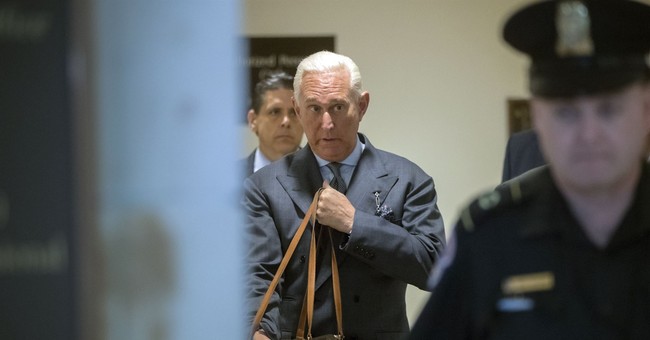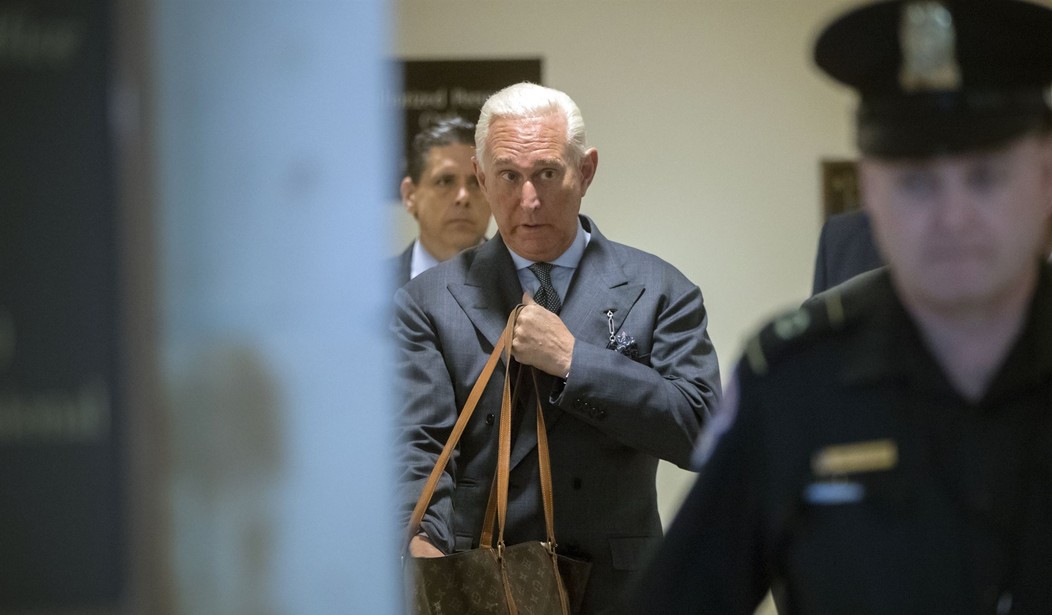
This is Part Three of my review of the Roger Stone case, specifically looking at the issue raised last week by former Special Counsel Office (SCO) prosecutor Aaron Zelinsky concerning whether improper political influence was involved in overriding the sentencing recommendation made by Zelinsky and three other “line prosecutors” who handled the trial.
Part One here looked at “Who Were Those Guys” — the FOUR prosecutors that were needed to handle a four day trial involving five witnesses. Answer — four guys who for the most part weren’t very experienced, and at least three of whom have demonstrated overt political hostility to the GOP and President Trump in the past. The two SCO prosecutors who stayed with the case after the SCO closed up shop were the two least experienced prosecutors with the SCO — and one of them was a civil appellate specialist who had likely never before been involved in a criminal trial.
Part Two here looked at some of the decisions made in charging the Stone case — which happened after the wider investigation into the Russia-Trump collusion allegations had revealed that narrative to be unfounded. Roger Stone did not make false statements or obstruct the SCO, but the SCO found it necessary to pursue a prosecution of Roger Stone for his conduct relating to a congressional inquiry. Did every witness who responded to or appeared before Congress get similar scrutiny? Is the fact that no other witness who responded to a congressional inquiry was charged mean that every other witness was 100% truthful? Why did Roger Stone’s responses to the House Intelligence Committee fall under the scrutiny of the SCO? Was it because he was a long-time friend of Pres. Trump and Paul Manafort, he was outspoken in support of them, and in his criticism of the SCO?
Part Three below looks more closely at the actual sentencing proceeding, the activity of Zelinsky & Company as part of that sentencing process, and the degree to which their actions actually deviated from DOJ policy notwithstanding Zelinsky’s loud protests to the House Judiciary Committee and to the media that the prosecutors were subjected to improper political interference.
The truth of the matter — if you understand the process — is that Zelinsky & Company proposed what is known as and “objectively unreasonable” sentence when they asked the Court to sentence a 67 year old first time offender to over 7 years in federal prison rather than a more typical term of between 2 and 4 years — largely because of hyperbolic and rhetorical “threats” made by Stone to someone who was a “frenemy.”
There are specific DOJ policies that detail how a federal prosecutor is to be involved in the process of sentencing the defendant in a criminal case. Zelinsky attempted to explain this subject in his written statement to the Judiciary Committee, claiming that Zelinsky & Company were compelled by DOJ policies to do what they did, while the changes made by “leadership” violated those same policies, and were the result of improper political considerations intended to please Pres. Trump.
Here is part of what Zelinsky wrote in his statement on this subject:
In the federal system, the imposition of sentence is reserved for the judge. But in order to promote fairness in sentencing, the law requires that every sentencing begins with a calculation of the Sentencing Guidelines applicable to the defendant and his offense…. The purposes of the Guidelines are to ensure that similarly situated defendants get similar sentences; to prevent the courts from basing sentences on impermissible considerations; and to ensure that sentences reflect the gravity of the defendant’s crime. While the Guidelines have their supporters and detractors, the Department of Justice’s official policy… is generally to recommend a sentence within the Guidelines range. Prosecutors are explicitly prohibited from seeking a below-Guidelines sentence without supervisory approval.
I want to first consider the bolded language, because although it is not explicitly false, it does not actually state the policy. I go into this in bit more detail in Part Four coming later, but what the policy actually says is that prosecutors shall not seek a sentence below the guidelines without first obtaining supervisory approval. The difference in the two phrasings is that — unlike the way Zelinsky phrased the issue — prosecutors CAN recommend a “below guidelines” sentence when they believe one is warranted based on the facts and circumstances of the case, they just have to obtain approval before they do so. Such recommendations are not “prohibited” – the only restriction is that “line prosecutors” cannot act on their own in making such a recommendation.
The way Zelinsky phrased the policy in his written statement is meant to suggest that the “line prosecutors” would have been violating DOJ policy if they had asked for any sentence less than 87 months — no matter the facts. He characterization is dishonest effort intended to shield them from being asked why they thought 87 months was a “just sentence” — that’s what DOJ policy dictated that they seek as is explained in more detail below. The obvious conclusion is that Zelinsky & Company WANTED an 87 month sentence for Roger Stone because they believed Roger Stone DESERVED an 87 month sentence. Given that no case cited by them — and to this day I’ve found no similar case exists in my research — has ever resulted in an 87 month sentence for a similarly situated defendant, the FACTS are that Zelinsky & Company SOUGHT a sentence for Stone that was not supported by any other DOJ prosecution of anyone anywhere ever in the country. EVER. So tell me again that Roger Stone was treated no differently than any other defendant by the SCO — but wait for me to put down my coffee first, I don’t want to spew it up all over my computer screen.
Aaron Zelinsky’s defense of his actions don’t pass the “laugh test.” His effort is all about avoiding criticism over the FACT that they never considered whether 87 months was a “just sentence” as they were REQUIRED by DOJ policy to do.
For the Department to seek a sentence below the Guidelines in a case where the defendant went to trial and remained unrepentant is in my experience unheard of – all the more so given Stone’s conduct in the lead-up to the trial. I was told at the time that no one in the Fraud and Public Corruption Section of the United States Attorney’s Office in the District of Columbia – which prosecuted the Stone case after the Special Counsel’s office completed its work – could even recall a case where the government did not seek a Guidelines sentence after trial.
Tell me again the funny one about the amount of “your experience.” And throw in for us the “experience” of your fellow SCO “prosecutor” Adam Jed — the guy from DOJ Civil Division, Appellate Section. And how many cases had Marando actually taken to trial in his five years with the DC US Attorney’s Office?
Fourth-man-in-the-scrum Jonathan Kravis was the Dep. Chief of the Fraud and Public Corruption Section, and Marando was assigned to that Section. Were those the two sources Zelinsky relied upon to make that statement that “no one in the Fraud Section….could even recall a case….?
Let us now turn to the Zelinsky’s explanation of how Zelinsky & Company arrived at the 87 month figure that was the sentence they recommended for Stone. I explained the process for going through the mechanics of the sentencing guidelines in Part Two.
In Zelinsky’s various comments I noticed that he sometimes conflated two different tasks of a prosecutor in the sentencing process — maybe he did so out of just wanting the simplify his explanation, but maybe he did so out of wanting to pull a light “sleight-of-hand.” Frankly, I’m not sure he’s bright enough for the latter, so I’m leaning towards the former.
He references sometimes interchangeably the task of “seeking a guideline sentence” and of “providing a calculation of the applicable guidelines” to the court. These are two separate tasks DOJ policy imposes on a prosecutor as part of the sentencing process — they are not two ways of describing the same task.
This is an important distinction because a prosecutor enjoys an amount of discretion in representing to the Court the mechanics of hows the guidelines should be calculated. The prosecutor can make judgments as to the applicability — or inapplicability — of particular guideline enhancements based on the facts.
Once the prosecutor makes those discretionary calls, and determines the guideline sentencing range that results based on that calculation, only THEN is prosecutor obligated by policy to recommend a sentence within that guideline range — unless he seeks and receives supervisory approval to recommend a sentence outside the guideline range.
But, every prosecutor in going through these steps must bear in mind the over-arching consideration expressed in DOJ Policy on the AUSA’s involvement in the sentencing process. DOJ Manual, Principles of Federal Prosecution § 9-27.710 states:
During the sentencing phase… the attorney for the government should assist the sentencing court by:
Attempting to ensure that the relevant facts and sentencing factors, as applied to the facts, are brought to the court’s attention fully and accurately; and
Making sentencing recommendations in appropriate cases.
Comment: Sentencing is a critical stage in a case, and prosecutors play an indispensable role in advocating for just sentences….
The very first section of the Policy Manuel providing guidance to prosecutors regarding their role and function in the sentencing process states they must be “advocating for just sentences.”
The obligations of the prosecutor are further detailed in the following section, 9-27.720, “Establishing a Factual Basis for Sentence”:
In order to ensure that the relevant facts are brought to the attention of the sentencing court fully and accurately, the attorney for the government should:
Cooperate with the Probation Service in its preparation of the presentence investigation report;
Review the presentence investigation report;
Highlight critical facts and sentencing considerations in a way that accurately and compellingly supports the government’s recommended sentence;
Make a factual presentation to the court when:
Sentence is imposed without a presentence investigation and report;
It is necessary to supplement or correct the presentence investigation report;
It is necessary in light of the defense presentation to the court; or
It is requested by the court;
Be prepared to substantiate significant factual allegations disputed by the defense; and
Provide an opportunity for victim allocution.
The Stone case went to trial. This is different from when a defendant pleads guilty, and the Court might have only a fraction of the evidence presented as part of the plea. In that situation the prosecutor works with the Probation Officer to include all the relevant facts in the Presentence Report since that is where the Judge will look to find out the full picture of the facts of the case.
But after a trial that is not necessary. The trial judge heard every witness, read every transcipt, examined every document in the same manner as was done by the jury. Sometimes there is “relevant conduct” not presented at trial that needs to be in the Presentence Report. As the policy states, the prosecutor is to work with the Probation Officer to make sure such information is included in the Report.
But let’s look at one of Zelinsky’s complaints about how Zelinsky & Company were told to change their draft Sentencing Statement they had prepared for approval before filing.
[S]enior U.S. Attorney’s Office leadership also communicated an instruction from the acting U.S. Attorney that we remove portions of the sentencing memorandum that described Stone’s conduct. Again, this instruction was inconsistent with the usual practice in the U.S. Attorney’s Office, and with the Department’s policy that attorneys for the government must ensure that relevant facts are brought the attention of the sentencing court fully and accurately.
The instruction was not inconsistent. As noted in the Manuel section quoted above, the prosecutor is to work with the Probation Officer to make sure all the necessary facts are set forth in the PSR. The Prosecutor can use the sentencing statement to supplement or correct errors in the PSR, or in response to defense arguments. But the Sentencing Statement is NOT a vehicle to recycle the government’s version of the facts of the case.
Pages 1 through 15 of Zelinsky’s Sentencing Statement is all “factual background.” It repeats the prosecutor’s view of the case. It is exactly what the Policy says to not do. The entire document is only 26 pages long – so 60% of what they filed was content that DOJ Policy says should be provided to the Probation Officer for inclusion in the Presentence Report for the Judge, not filed separately in a sentencing statement.
The instruction to remove the description of Stone’s conduct was a direction to make the memorandum comply with DOJ policy – not to violate DOJ policy. Zelinsky attempts to use the words of the policy to defend his conduct, but the policy refers to providing assistance to the Probation Officer in preparing the PSR, it does not refer to what a prosecutor must put in a sentencing statement.
Aaron Zelinsky didn’t understand his job. Simple as that.
This is not a complicated issue – when a federal prosecutor understands that his job description no where uses the word “Crusader”. The Presentence Report is an official document of the United States District Court. It goes in the defendant’s file, and follows him to the facility where he serves his time. It informs the Bureau of Prisons about “Who this prisoner is and what did he do,” issues that assist BOP in making its decisions on how to “accommodate” that prisoner within its system. It includes a comprehensive analysis of the facts and the law that supports the defendant’s conviction and sentence, as well as a detailed background of who the prisoner is as a person based on his family history, work history, etc.
The reason to not include all the same facts in the government sentencing statement as were presented at trial, and as are set forth in the PSR, is because doing so leads to a waste of the Court’s time. A sentencing statement is filed because you want the Court to read and consider it. But when 60% of the document is a telling of facts that 1) repeat the trial testimony, and 2) repeat the facts in the Presentence Report, then you have just wasted the time spent by the judge in reading what you filed, and likely lost their interest in the 40% that comes after the facts they didn’t need to read — again.
The idea that Judge Amy Berman Jackson, with nine years on the bench and maybe as many as 2000 prior criminal sentencings under her belt, needed the wisdom of Zelinsky & Company to guide her in determining an appropriate sentence for Roger Stone is simply nonsensical prattle from him.
Part Four will examine why the recommendation of 87 months from Zelinsky & Company was nothing less than stupid, as reflected in the decision from DOJ to withdraw that recommendation, and as validated by Judge Berman-Jackson when she ignored it as “objectively unreasonable.”
If only Zelinsky & Company had thought for a moment to consider the question. It was, after all, part of their job.














Join the conversation as a VIP Member